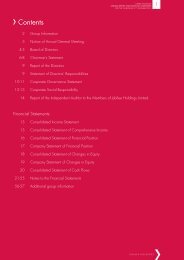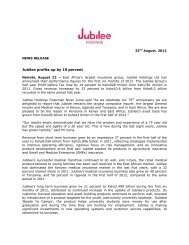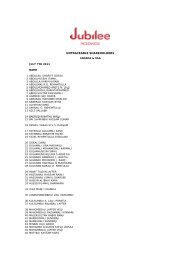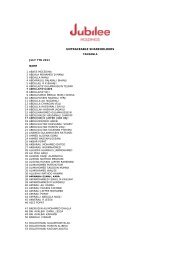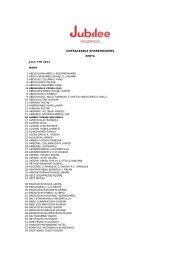Annual report - front page - Jubilee Insurance
Annual report - front page - Jubilee Insurance
Annual report - front page - Jubilee Insurance
- No tags were found...
You also want an ePaper? Increase the reach of your titles
YUMPU automatically turns print PDFs into web optimized ePapers that Google loves.
NOTES TO THE FINANCIAL STATEMENTSAS AT 31ST DECEMBER 2011 (CONTINUED)3. CRITICAL ACCOUNTING ESTIMATES AND JUDGEMENTS IN APPLYING ACCOUNTING POLICIES (CONTINUED)e) Valuation of unquoted sharesThe Group uses valuation techniques for valuing unquoted shares that are not based on observable market data. The criticalmanagement judgment is in the selection of the price earnings ratio applied and the determination of normalized earningsfor the underlying investmentsf) Carrying value of investment in associateThe carrying value of some of the associates companies is dependent on the complex valuation of the underlying operatingentities. These valuations apply discounted cash flow techniques which are subject to judgment as to the future cash flows.4. MANAGEMENT OF INSURANCE AND FINANCIAL RISKThe Group’s activities expose it to a variety of risks, including insurance risk, financial risk, credit risk, and the effects ofchanges in property values, debt and equity market prices, foreign currency exchange rates and interest rates. The Group’soverall risk management programme focuses on the identification and management of risks and seeks to minimise potentialadverse effects on its financial performance, by use of underwriting guidelines and capacity limits, reinsurance planning,credit policy governing the acceptance of clients, and defined criteria for the approval of intermediaries and reinsurers.Investment policies are in place which help manage liquidity, and seek to maximise return within an acceptable level ofinterest rate risk.This section summarises the way the Group manages key risks:(i)<strong>Insurance</strong> riskThe risk under any one insurance contract is the possibility that the insured event occurs and the uncertainty of the amountof the resulting claim. By the very nature of an insurance contract, this risk is random and therefore unpredictable.For contracts without fixed terms, it is assumed that the Group will be able to increase mortality risk charges in future yearsin line with emerging mortality experience.Estimates are also made as to future investment income arising from the assets backing long-term insurance contracts.These estimates are based on current market returns as well as expectations about future economic and financialdevelopments. The average estimated rate of investment return is 8% p.a., were the average future investment returns toincrease by 4% from management’s estimates, the insurance liability would increase by Shs 252 million while significantenough deterioration in estimates is immediately recognized to make the liabilities adequate.For a portfolio of insurance contracts where the theory of probability is applied to pricing and provisioning, the principal riskthat the Group faces under its insurance contracts is that the actual claims and benefit payments exceed the carrying amountof the insurance liabilities. This could occur because the frequency or severity of claims and benefits are greater thanestimated. <strong>Insurance</strong> events are random and the actual number and amount of claims and benefits will vary from year to yearfrom the level established using statistical techniques.Experience shows that the larger the portfolio of similar insurance contracts, the smaller the relative variability about theexpected outcome will be. In addition, a more diversified portfolio is less likely to be affected across the board by a changein any subset of the portfolio. The Group has developed its insurance underwriting strategy to diversify the type of insurancerisks accepted and within each of these categories to achieve a sufficiently large population of risks to reduce the variabilityof the expected outcome.Factors that aggravate insurance risk include lack of risk diversification in terms of type and amount of risk, geographicallocation and type of industry covered.The following tables disclose the maximum insured risk (sum assured) by the class of business in which the contract holderoperates and included in the terms of the policy. The amounts are the carrying amounts of the insurance liabilities (gross andnet of reinsurance) arising from insurance contracts.JUBILEE HOLDINGS LIMITED<strong>Annual</strong> Report and Financial Statements 2011 37



